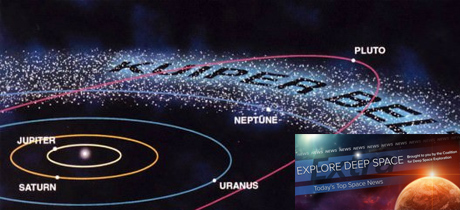In Today’s Deep Space Extra… Weather again delays the return of the Ax-1 mission to Earth and the launch of the Crew-4 mission to the ISS. Perseverance’s Mastcam-Z camera catches solar eclipse from Mars.
Human Space Exploration
Weather delays Ax-1 return
Coalition Member in the News – Axiom Space
SpaceNews.com (4/20): NASA and Axiom Space have moved the departure of the Axiom-1 (Ax-1) mission from late Thursday to Saturday night at the earliest due to unfavorable weather in the splashdown and recovery zones in the waters off the Florida peninsula. The decision announced overnight by NASA and Axiom moves the launch of NASA’s Crew-4 astronauts from the Kennedy Space Center (KSC) from early Saturday to early next Tuesday to embark on a six-month tour of duty aboard the ISS. The Ax-1 crew departure opens a docking port on the ISS U.S. segment Harmony module for the Crew-4 astronauts to park. The backup opportunities for Crew-4 are on Wednesday and Thursday.
Space Science
NASA’s Mars rover captured a partial eclipse of the Sun
Independent (4/20): NASA’s Perseverance Mars rover captured footage of Phobos, Mars’ potato-shaped moon, crossing the face of the Sun. According to NASA, these observations can help to better understand Phobos’ orbit and how its gravity pulls on the Martian surface, ultimately shaping the planet’s crust and mantle. The eclipse, which lasted 40 seconds, was captured with Perseverance’s next-generation Mastcam-Z camera on April 2, the 397th Martian day, or sol, of the mission. The eclipse lasted a little over 40 seconds, much shorter than a typical solar eclipse involving Earth’s Moon.
Astrobotic unveils private robotic lunar lander it aims to launch to the Moon this year
Coalition Member in the News – United Launch Alliance
The Verge (4/20): Astrobotic was joined Wednesday by NASA Administrator Bill Nelson for the unveiling of the company’s Peregrine lunar lander, which was developed as part of the agency’s Commercial Lunar Payload Services (CLPS) initiative. The lander is scheduled to launch late this year on the United Launch Alliance’s (ULA) new Vulcan Centaur rocket with NASA science and technology payloads, as well as those from academia, private companies, and different countries. Astrobotic will provide the control room for the lunar activities. Houston-based Intuitive Machines, another NASA CLPS commercial provider, is also preparing to launch its first mission this year.
Strong Earth-directed solar flare
Spaceweather.com (4/21): The sun has generated a surprising number of solar flares since the week began. The latest have caused shortwave radio blackouts and static in various parts of the Earth.
Pluto’s orbit is surprisingly unstable
Universe Today (4/20): Pluto, discovered in 1930 and once but no longer classified as a planet, resides in a long-term stable orbit around the sun but one that is vulnerable to short term perturbations, according to a new research effort. One orbit of the sun by Pluto spans 248 Earth years and with a trajectory inclined 17 degrees to the ecliptic plane, a source of mystery. NASA’s New Horizons mission carried out the first close flyby of Pluto in the summer of 2015, providing a glimpse of what may be a geophysically active planetary object. Findings were published in the Proceedings of the National Academy of Sciences.
Other News
Space Force looking at U.S. needs for ‘responsive space’
Coalition Member in the News – Northrop Grumman
SpaceNews.com (4/20): The U.S. Space Force plans to conduct in 2023 a “responsive space” demonstration where private launch companies will be challenged to deploy satellites on short notice. The demonstration is part of a congressionally directed effort to create a “tactically responsive launch” program. Congress added $50 million to the latest defense budget, arguing the Department of Defense (DoD) should be prepared to replace damaged satellites or deploy new ones quickly if needed. The congressional add-on will fund a demonstration not just of launch vehicles but also of capabilities to integrate payloads faster.
Canada’s answer to Space Force
SpaceNews.com (4/20): Canada’s military plans to join the U.S. and other allies in establishing a space force, though one much smaller. The Canadian Space Division, which would be responsible to the commander of the Royal Canadian Air Force, is to be established perhaps within the next eight months.
South Korea’s double-digit space budget boost
SpaceNews.com (4/20): South Korea is boosting its space spending this year by 19% over 2021 levels. The $619 million that the country will invest in space programs in 2022 is 15% more than the amount originally proposed. The difference between the final budget and what was initially sought is rare, indicating the growth opportunity South Korea’s government sees for its domestic space industry, according to An Hyoung-joon, a research fellow at the Science and Technology Policy Institute, a state-funded think tank based in Sejong.
OneWeb signs contract to launch satellites from India in 2022
Coalition Members in the News – Beyond Gravity, United Launch Alliance
SpaceNews.com (4/20): OneWeb has signed a contract to use India’s largest launch vehicle to deploy at least some of its remaining LEO broadband satellites this year, according to a company executive. The U.K.-based megaconstellation startup said in an April 20 news release it has reached an agreement with New Space India Limited, Indian space agency ISRO’s commercial arm, that covers launches from Satish Dhawan Space Centre for an undisclosed number of satellites. The first launch with New Space India is anticipated in 2022.

